|
|
Hazards/Solution:
Workers may strike their head on nearby
equipment or slip and fall due to uneven surfaces or poor
lighting.
- Work areas under mills must be as evenly surfaced as
conditions permit. They must be free from unnecessary
obstructions and lighting in accordance with
American National Standard for Industrial Lighting A11.1-1965, which is
incorporated by reference as specified in Sec. 1910.6.
1910.265(c)(2)
|

|
|
|
|
Hazards/Solution:
A load may strike or crush workers due to
failure in the supporting structure.
- All buildings, docks, tramways, walkways, log dumps,
and other structures must be designed, constructed and maintained so as
to support the imposed load in accordance with a safety factor.
1910.265(c)(1)
|

|
|
|
|
Hazards/Solutions:
A load or falling objects may strike workers if flooring has
openings or if it does not properly
support the load.
- Flooring in buildings and on ramps and walkways must be
constructed and installed in accordance with established principles of
mechanics and sound engineering practices. The flooring must support the
load upon it and the stress cannot exceed the allowable stress for
the material being used.
1910.265(c)(3)
- Areas under floor openings must, where
practical, be fenced off. When this is not practical, they need to be
plainly marked and telltales must be installed to hang over these
areas.
1910.265(c)(3)(ii)
|
|
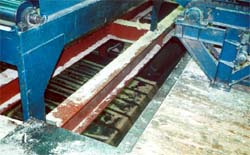
Unguarded chute floor opening in
sawmill
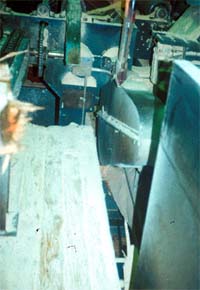
Unguarded chute floor opening in
sawmill
|
Workers could trip and fall if
flooring is not kept in good repair.
- The flooring of buildings, docks, and passageways
must be kept in good repair. When a hazardous condition develops that
cannot be immediately repaired, the area must be guarded until adequate
repairs are made. 1910.265(c)(3)(iii)
- Floors, footwalks, and passageways in the work area
around machines or other places where a person is required to stand or
walk must have effective means to minimize slipping. 1910.265(c)(3)(iv)
|

|
|
|
|
Hazards/Solutions:
Workers may fall from walkways, docks, or platforms if proper safety
measures are not in place. Also, the materials on an elevated platform
may roll or fall off the platform and strike workers.
- Walkways, docks, and platforms must be wide enough to
provide adequate passage and working areas.
1910.265(c)(4)(i)
- Walkways and stairways with
standard handrails must be provided in elevated and hazardous
locations. Where such passageways are over walkways or work areas,
standard toe boards must be provided. 1910.265(c)(4)(vi)
|
|
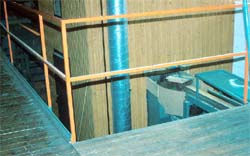
Properly guarded walkway
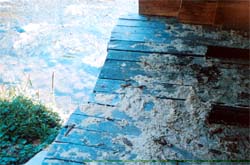
Unguarded walkway
|
- Docks and runways used for the operation of lift trucks and
other vehicles must have a substantial guard or shear timber, except
where loading and unloading are being performed. 1910.265(c)(4)(iii)
- Walkways must be evenly floored and kept in good
repair. 1910.265(c)(4)(ii)
|
|
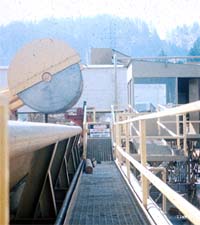
Walkway adjacent to
cut off saw
|
- All elevated walks, runways, or platforms, if four feet
or more from the floor level, must have a standard railing
except on loading or unloading sides of platforms. If height exceeds six
feet, a standard toe board also must be provided to prevent material
from rolling or falling off. 1910.265(c)(4)(iv)
- Elevated platforms that are used on a
daily basis must be equipped with stairways or fixed ladders in
accordance with 1910.27.
1910.265(c)(4)(v)
|
|
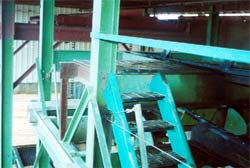
Unguarded, elevated work
platform on drop sorter
|
|

|
|
|
|
Hazard/Solutions:
Workers may trip and fall if
stairways lack proper handrails or if they are poorly
lighted or constructed.
- Stairways must be constructed in accordance with
1910.24. 1910.265(c)(5)(i)
- Stairways must have a standard handrail on at
least one side or on any open side. Stairs that are more than four feet
wide must have a standard handrail at each side, and where more
than eight feet wide, a third standard handrail must be erected in the
center of the stairway. 1910.265(c)(5)(ii)
- All stairways must be adequately lighted as prescribed in
paragraph (c)(9) of this section. 1910.265(c)(5)(iii)
|
|

Defective stairs
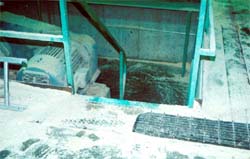
Tripping hazard at top of stairs
|
|

|
|
|
|
Hazard/Solutions:
Workers may be injured when exiting the facility if
vulnerable to moving traffic or other hazards.
- Doors must not open directly on or block a flight of
stairs, and must swing in the direction of exit travel.
1910.265(c)(6)(i)
- Exits must be easily located and identified from all work areas.
1910.265(c)(6)(ii)
- All swinging doors must have windows;
with one window for each section of double swinging doors. Such windows
must be made of shatterproof or safety glass or otherwise protected
against breakage. 1910.265(c)(6)(iii)
- Where sliding doors are used as exits, an inner door
must be cut inside each of the main doors and arranged to open outward. 1910.265(c)(6)(iv)
- Where a doorway opens upon a railroad
track or upon a tramway or dock over which vehicles travel, a barrier or
other warning device must be present to prevent workers from stepping
into moving traffic.
1910.265(c)(6)(v)
|

|
|
|
|
Hazard/Solution:
Workers may suffer from a variety of
health hazards if proper ventilation is not in place.
- Ventilation must be provided to supply
healthful air to rooms, buildings, and work areas.
1910.265(c)(7)
|

|
|
|
|
Hazard/Solution:
Workers may fall into unguarded vats or
tanks.
- All open vats and tanks into which
workers could fall must be guarded.
1910.265(c)(8)
|

|
|
|
|
Hazard/Solutions:
Inadequate or ineffective lighting may cause eye
strain. Poor lighting may also result in accidental contact or collision
with nearby equipment.
- Provided adequate illumination in rooms, buildings, and work areas
during the time of use.
1910.265(c)(9)(i)
- Factors upon which the adequacy and effectiveness of
illumination will be judged, include the following: 1910.265(c)(9)(ii)
- The quantity of light in foot-candle intensity must be sufficient
for the work being done. 1910.265(c)(9)(ii)(a)
- The quality of the light must be free from glare
and have correct direction, diffusion, and distribution. 1910.265(c)(9)(ii)(b)
- Shadows and extreme contrasts must be avoided or kept to a minimum.
1910.265(c)(9)(ii)(c)
|

|
|
|
|
Hazard/Solution:
Workers may be struck by equipment or
loads if proper hazard markings are not in place.
- Physical hazard marking
must be as specified in
1910.144 of this part. 1910.265(c)(11)
|

|
|
|
|
Hazard/Solution:
Toxic fumes from a gas leak may make
workers sick. A gas leak also may lead to a fire or
explosion if ignited.
- All gas piping and appliances must be
installed in accordance with the American National Standard Requirements
for the Installation of Gas Appliances and Gas Piping Z21.30-1964, which
is incorporated by reference as specified in Sec. 1910.6. 1910.265(c)(15)
|

|
|
|
|
Hazard/Solutions:
Workers may be cut by the saw blade if it is not properly
guarded. Stellite tipped saw blades generate a fine dust containing
cobalt when sharpened.
Cobalt is a silvery, bluish-white, odorless, and magnetic metal. The fume and dust of cobalt metal is odorless and black.
Without proper ventilation, cobalt overexposures are possible.
Cobalt also is combustible and burns in air at room temperature. Dusts of cobalt metal or cobalt compounds may form explosive mixtures in air.
- Ensure that a local exhaust ventilation system is
used and maintained. 1910.265(c)(20)
- All saw blades and abrasive wheels must be
adequately guarded. 1910.151(f)(1)
-
Methods that are effective in controlling worker exposures to cobalt metal, dust, and fume, depending on the feasibility of implementation, are as
follows:
- Process enclosure,
- Local exhaust ventilation,
- General dilution ventilation, and
- Personal protective equipment.
- Remove an incapacitated worker from further exposure and implement appropriate emergency procedures (e.g., those listed on the Material Safety Data Sheet required by OSHA's
Hazard Communication Standard. All workers should be familiar with emergency procedures, the location and proper use of emergency equipment, and methods of protecting themselves during rescue operations.
- Extinguishant: DO NOT USE WATER. Dry sand, dry dolomite, dry graphite powder, or sodium chloride have been recommended for fighting fires involving cobalt.
Fires involving cobalt metal, dust, and fume should be fought upwind from the maximum distance possible. Isolate the hazard area and deny access to unnecessary personnel. Firefighters should wear a full set of protective clothing and self-contained breathing apparatus when fighting fires involving cobalt metal, dust, and
fume.
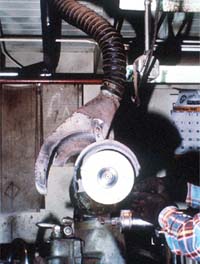
Local exhaust
ventilation system
|
|
|
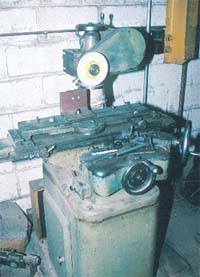
Unguarded abrasive wheel on saw blade sharpener machine.
Note the lack of a local exhaust ventilation on wet system for dust
generated during sharpening.
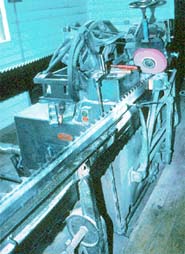
Band saw sharpening machine.
Note the unguarded abrasive wheel.
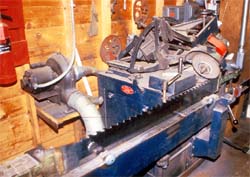
Band saw sharpening machine.
Note the unguarded abrasive
wheel.
|
|

|
|
|
